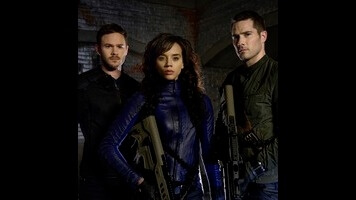From Boba Fett to Dog The, pop culture loves its bounty hunters. They work a sleazy, dangerous, and alluring beat that treats low-life scofflaws to high-octane thrills. The fantasy of hauling in an unruly perp to collect a serious cash reward endures in Syfy’s new drama Killjoys, which takes romanticized thuggery to a star system far, far away. Its protagonists are reclamation agents, which is another term for bounty hunters, which itself is another term for Killjoys. Synonyms are alive and well in Killjoys’ vision of the future.
Her partner-in-crime busting, John Jaqobis (Aaron Ashmore), is a tech-savvy sidekick with a sarcastic streak. The two share a well-oiled platonic relationship replete with years of personal history. For Dutch-related sexual tension, Killjoys turns to John’s formerly estranged brother D’Avin (Luke Macfarlane), the team’s newest recruit. He’s a rugged ex-soldier whose tactical and combat brilliance is slowly giving way to PTSD.
As employees of the Reclamation Apprehension Coalition, or RAC, the three Killjoys chase hardened fugitives throughout the Quad, a planet and three orbiting moons on the verge of violent class warfare. Despite the RAC’s independent status, its biggest client is the Company, a morally ambiguous body that governs over the Quad territories.
The term “stylized grittiness” sounds like an oxymoron, but it fits Killjoys. The series’ washed-out color palette lets viewers know that the future ain’t no rainbow-paved cakewalk. Dutch, John, and D’Avin can each take a good face-punch, and they aren’t above saying the word “shit” when events warrant. Yet there’s a disconnect in play here: The leads are younger, more attractive, and trendier than they have any business being, which places their world-weary austerity under suspicion. They’re too pretty to be gritty.
Killjoys takes its cues from some of the new millennium’s most influential science-fiction television, pulling elements from Battlestar Galactica, Firefly, and Orphan Black into its reverent tractor beam. (The show comes from Temple Street, Orphan Black’s Toronto-based production company.) While functioning as a bounty-of-the-week procedural, the series also strives for an overarching mythology. As with Battlestar and Firefly, Killjoys goes light on the planetary nerdiness; in lieu of aliens sporting varying degrees of forehead ridges, it keeps things human (literally) with a backdrop of civil unrest and government abuses. The Quad is a complex place, a sociopolitical tinderbox whose murky past is primed and ready to catch up with it. Dutch’s personal narrative runs in tandem with the Quad: The cryptic mentor who schooled her as a child has suddenly reappeared, assigning a deadly task (and possibly more down the line) she’s unable to refuse. After years of sculpting her into a cold-blooded assassin, he’s looking for a return on his investment.
Although Killjoys has ambition and creativity to spare, it often lags in execution. Compelling storylines find themselves saddled with heavy-handed exposition and clunky, B-grade dialogue. When serving up our Killjoys’ characteristics and values, attributes like “tough,” “sarcastic,” and “mysterious” should be treated as condiments, not the main course. Despite solid acting, our leads are handcuffed to what’s on the page, with no opportunity to transcend stock character templates. Dutch, John, and D’Avin would seem fleshed-out by the standards of video game cut scenes, but their pixilated qualities swiftly reveal themselves when patched into a steely television drama. Ancillary characters—like Dutch’s hoity-toity frenemy Delle Seyah Kendry or sassy gay bartender Pree—are painted with even broader strokes.
In its current state, Killjoys is stranded in a tone-divested neutral zone, perilously low on the fuel needed to keep up with its influences. It’s too perfunctory to attain the gravitas of Battlestar Galactica and Orphan Black, with not enough of the heart and pitch-perfect humor that made Firefly so engaging. Fortunately, there’s a sound infrastructure in place. Killjoys’ premise is solid, the storylines original, the CG tasteful, and the action sequences finely choreographed. Extra praise is reserved for the art department, which does a formidable job presenting the utopian/dystopian paradox that makes up the Quad. Like a fixer-upper house with good bones, a few light renovations may be all Killjoys needs to transform into something worth inhabiting.

